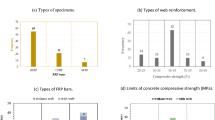Abstract
In structural analysis, especially in indeterminate structures, it becomes essential to know material and geometrical properties of members. The codal provisions recommend elastic properties of concrete and steel and these are fairly accurate enough. The stress–strain curve for concrete cylinder or a cube specimen is plotted. The slope of this curve is modulus of elasticity of plain concrete. Another method of determining modulus of elasticity of concrete is by flexural test of a beam specimen. The modulus of elasticity most commonly used for concrete is secant modulus. The modulus of elasticity of steel is obtained by performing a tension test of steel bar. While performing analysis by any software for high rise building, cross area of plain concrete is taken into consideration whereas effects of reinforcement bars and concrete confined by stirrups are neglected. The aim of study is to determine elastic properties of reinforced cement concrete material. Two important stiffness properties such as AE and EI play important role in analysis of high rise RCC building idealized as plane frame. The experimental programme consists of testing of beams (model size 150 × 150 × 700 mm) with percentage of reinforcement varying from 0.54 to 1.63%. The experimental results are verified by using 3D finite element techniques. This study refers to the effect of variation of percentage of main longitudinal reinforcement and concrete grade. Effect of confinement is not considered and it appears in a separate study.






























Similar content being viewed by others

References
Akmaluddin A and Thomas C 2007 Experimental verification of effective moment of inertia used in the calculation of reinforced concrete beam deflection. Int. Civil Eng. Conference Towards Sustainable Civil Eng. Practice 89–98
Amer M and Huda M M 2009 Finite element modeling of continuous RC beam. Eur. J. Scientific Res. 30(1): 177–186
Amir S, Kent A H and Bahram M S 2013 Crack opening behavior of concrete reinforced with high strength reinforcing steel. Int. J. Concrete Structures and Materials 7(4): 253–264
Antonio F B and Gabriel O R 1998 Analysis of reinforced concrete structures using ansys. Computational Mechanics 1–7
Ghali A 1993 Deflection of reinforced concrete members: A critical review. ACI Structural J. 90(4): 364–373
IS 456:2000 Code of practice for plain and reinforced concrete. New Delhi, India
IS 516:1959 (Reaffirmed 2004) Methods of tests for strength of concrete. New Delhi, India
Khuntia M and Ghosh S K 2004a Flexural stiffness of reinforced concrete columns and beams: Analytical approach. ACI Structural J. 101(3): 351–363
Khuntia M and Ghosh S K 2004b Flexural stiffness of reinforced concrete columns and beams: Experimental verification. ACI Structural J. 101(3): 364–373
Patil S S, Shaikh A N and Niranjan B R 2012 Nonlinear finite element method of analysis of reinforced concrete deep beam. Int. J. Modern Eng. Res. 2(6): 4622–4628
Siddique M A and Rouf M A 2006 Effect of material properties on behaviour of over-reinforced concrete beams. Asian J. Civil Eng. (Building and Housing) 7(2): 195–204
Soroushian P, Sim J and Hsu J W 1991 Axial/Flexural behaviour of reinforced concrete sections: Effects of the design variable. ACI Structural J. 88(1): 17–21
Srikanth M, Kumar R G and Giri S 2007 Moment curvature of reinforced concrete beams using various confinement models and experimental validation. Asian J. Civil Eng. (Building and Housing) 8(3): 247–265
Vasudevan G and Kothandaraman S 2011 Parametric study on Nonlinear Finite Element Analysis on flexural behaviour of RC beams using ANSYS. Int. J. Civil Structural Eng. 2(1): 98–111
Acknowledgements
The experiments were carried out under the research project funded by University of Pune. The authors are thankful to University of Pune for the financial support. The authors also thank Sinhgad College of Engineering, Pune for all the facility to carry out experiments in the laboratory.
Author information
Authors and Affiliations
Corresponding author
Rights and permissions
About this article
Cite this article
KULKARNI, S.K., SHIYEKAR, M.R., SHIYEKAR, S.M. et al. Elastic properties of RCC under flexural loading-experimental and analytical approach. Sadhana 39, 677–697 (2014). https://doi.org/10.1007/s12046-014-0245-6
Received:
Revised:
Accepted:
Published:
Issue Date:
DOI: https://doi.org/10.1007/s12046-014-0245-6



